A Comprehensive Analysis of LinkedIn's Variable Pay Structure
VerifiedAdded on 2023/01/17
|17
|3852
|38
Report
AI Summary
This report provides a comprehensive analysis of LinkedIn's variable compensation structure. It begins with a description of the company and its compensation model, which includes non-monetary, direct, and indirect compensation components. The report then delves into the advantages and disadvantages of variable pay, such as fixed cost reduction and increased productivity versus potential measurement errors and competition among employees. The analysis further examines LinkedIn's specific variable compensation strategies, including sales commissions, bonuses, and management objectives, while also referencing Herzberg's Two-Factor Theory to explain employee motivation. The report also discusses the pros and cons of the 'peanut butter approach' to bonus distribution and concludes with a recommendation for a suitable compensation plan and its potential benefits for LinkedIn. The report highlights the importance of aligning compensation with employee performance and overall company goals.
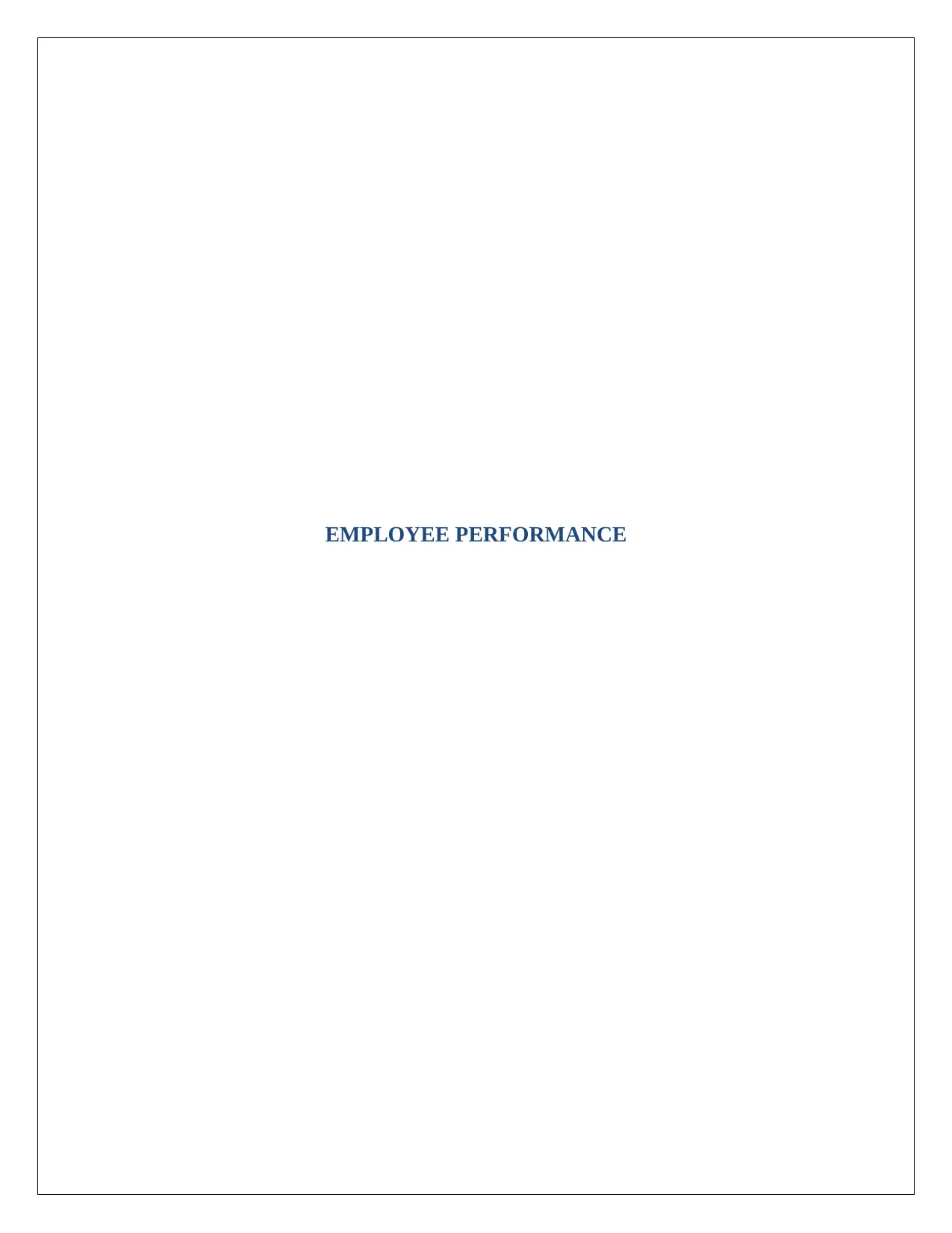
EMPLOYEE PERFORMANCE
Paraphrase This Document
Need a fresh take? Get an instant paraphrase of this document with our AI Paraphraser
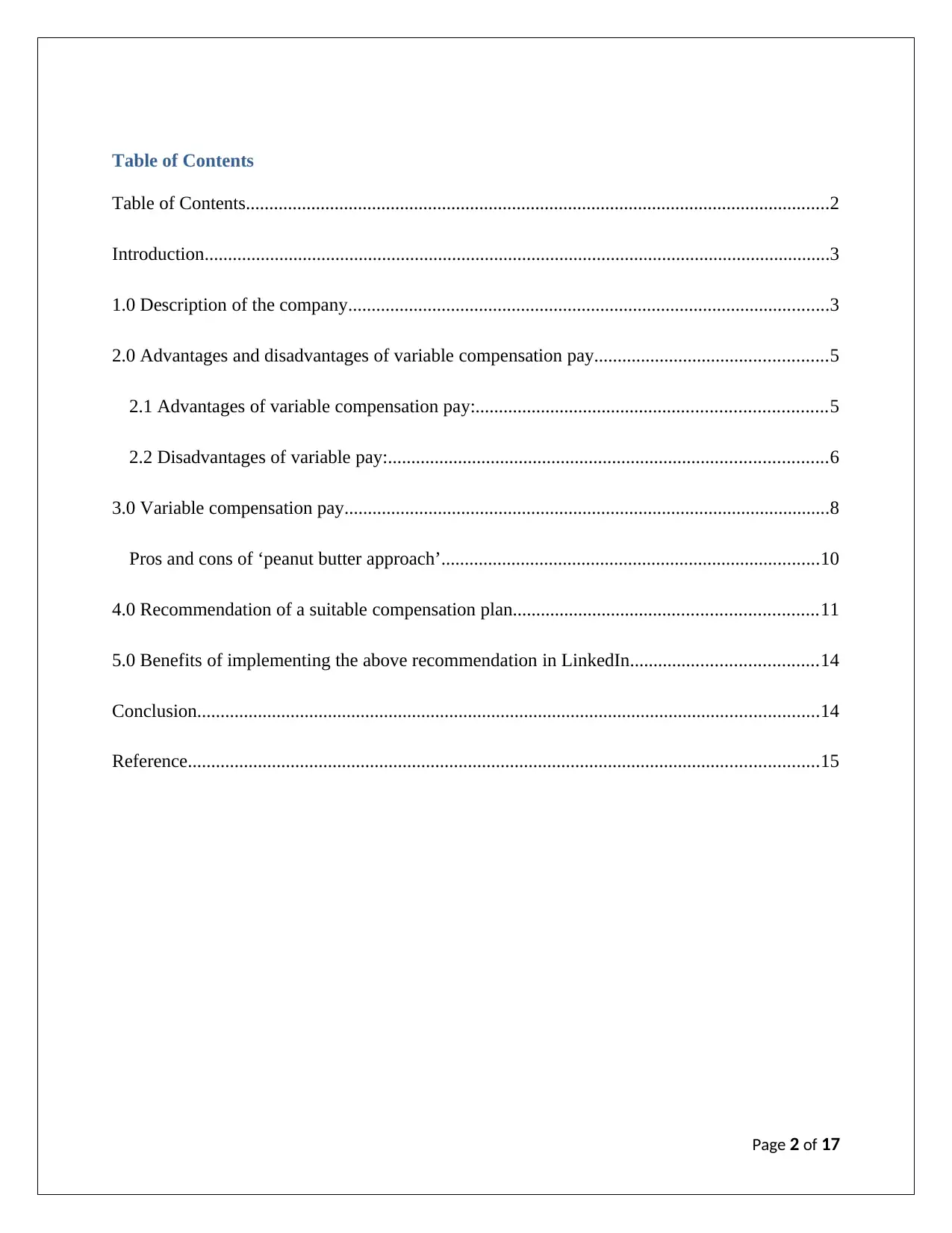
Table of Contents
Table of Contents.............................................................................................................................2
Introduction......................................................................................................................................3
1.0 Description of the company.......................................................................................................3
2.0 Advantages and disadvantages of variable compensation pay..................................................5
2.1 Advantages of variable compensation pay:...........................................................................5
2.2 Disadvantages of variable pay:..............................................................................................6
3.0 Variable compensation pay........................................................................................................8
Pros and cons of ‘peanut butter approach’.................................................................................10
4.0 Recommendation of a suitable compensation plan.................................................................11
5.0 Benefits of implementing the above recommendation in LinkedIn........................................14
Conclusion.....................................................................................................................................14
Reference.......................................................................................................................................15
Page 2 of 17
Table of Contents.............................................................................................................................2
Introduction......................................................................................................................................3
1.0 Description of the company.......................................................................................................3
2.0 Advantages and disadvantages of variable compensation pay..................................................5
2.1 Advantages of variable compensation pay:...........................................................................5
2.2 Disadvantages of variable pay:..............................................................................................6
3.0 Variable compensation pay........................................................................................................8
Pros and cons of ‘peanut butter approach’.................................................................................10
4.0 Recommendation of a suitable compensation plan.................................................................11
5.0 Benefits of implementing the above recommendation in LinkedIn........................................14
Conclusion.....................................................................................................................................14
Reference.......................................................................................................................................15
Page 2 of 17
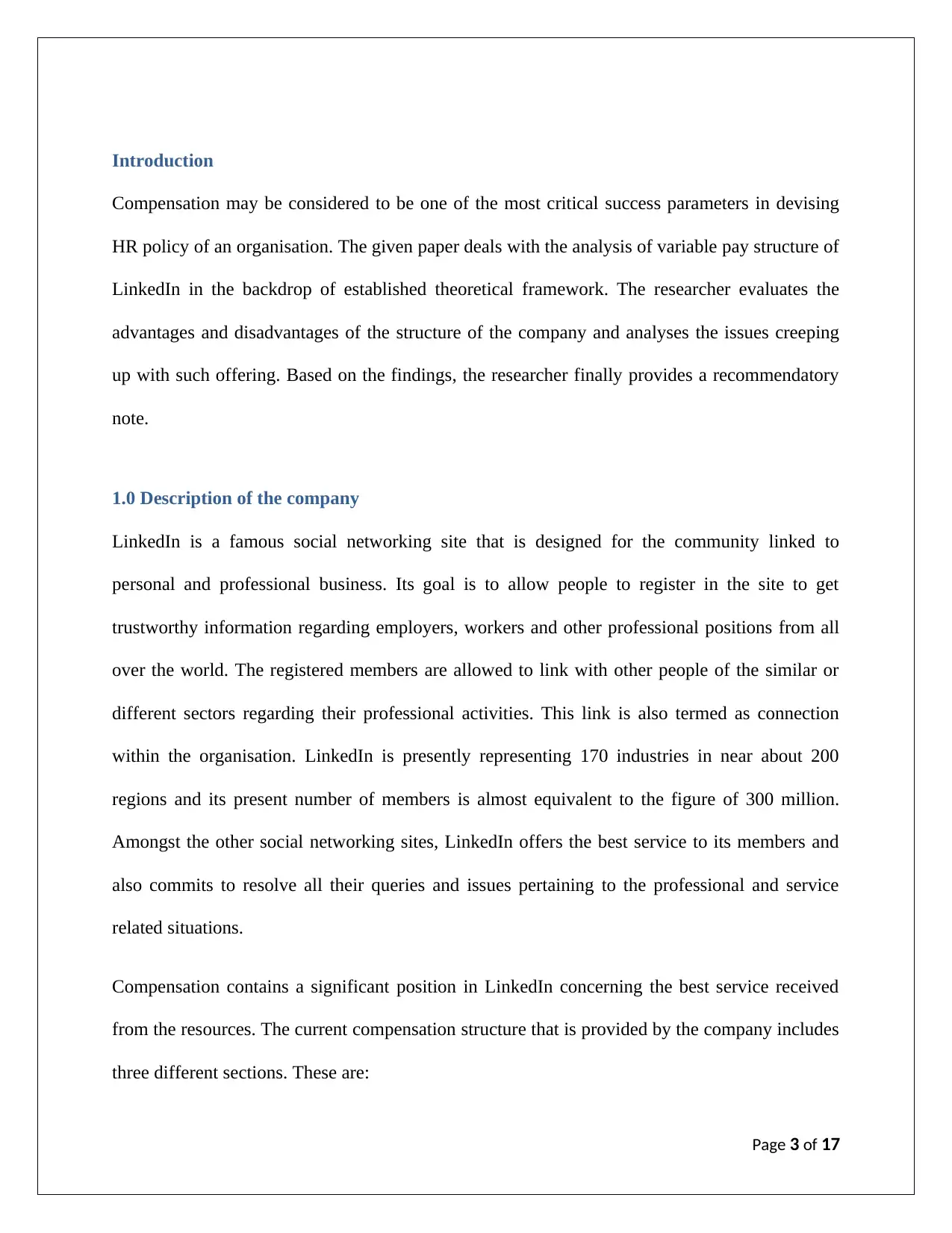
Introduction
Compensation may be considered to be one of the most critical success parameters in devising
HR policy of an organisation. The given paper deals with the analysis of variable pay structure of
LinkedIn in the backdrop of established theoretical framework. The researcher evaluates the
advantages and disadvantages of the structure of the company and analyses the issues creeping
up with such offering. Based on the findings, the researcher finally provides a recommendatory
note.
1.0 Description of the company
LinkedIn is a famous social networking site that is designed for the community linked to
personal and professional business. Its goal is to allow people to register in the site to get
trustworthy information regarding employers, workers and other professional positions from all
over the world. The registered members are allowed to link with other people of the similar or
different sectors regarding their professional activities. This link is also termed as connection
within the organisation. LinkedIn is presently representing 170 industries in near about 200
regions and its present number of members is almost equivalent to the figure of 300 million.
Amongst the other social networking sites, LinkedIn offers the best service to its members and
also commits to resolve all their queries and issues pertaining to the professional and service
related situations.
Compensation contains a significant position in LinkedIn concerning the best service received
from the resources. The current compensation structure that is provided by the company includes
three different sections. These are:
Page 3 of 17
Compensation may be considered to be one of the most critical success parameters in devising
HR policy of an organisation. The given paper deals with the analysis of variable pay structure of
LinkedIn in the backdrop of established theoretical framework. The researcher evaluates the
advantages and disadvantages of the structure of the company and analyses the issues creeping
up with such offering. Based on the findings, the researcher finally provides a recommendatory
note.
1.0 Description of the company
LinkedIn is a famous social networking site that is designed for the community linked to
personal and professional business. Its goal is to allow people to register in the site to get
trustworthy information regarding employers, workers and other professional positions from all
over the world. The registered members are allowed to link with other people of the similar or
different sectors regarding their professional activities. This link is also termed as connection
within the organisation. LinkedIn is presently representing 170 industries in near about 200
regions and its present number of members is almost equivalent to the figure of 300 million.
Amongst the other social networking sites, LinkedIn offers the best service to its members and
also commits to resolve all their queries and issues pertaining to the professional and service
related situations.
Compensation contains a significant position in LinkedIn concerning the best service received
from the resources. The current compensation structure that is provided by the company includes
three different sections. These are:
Page 3 of 17
⊘ This is a preview!⊘
Do you want full access?
Subscribe today to unlock all pages.

Trusted by 1+ million students worldwide
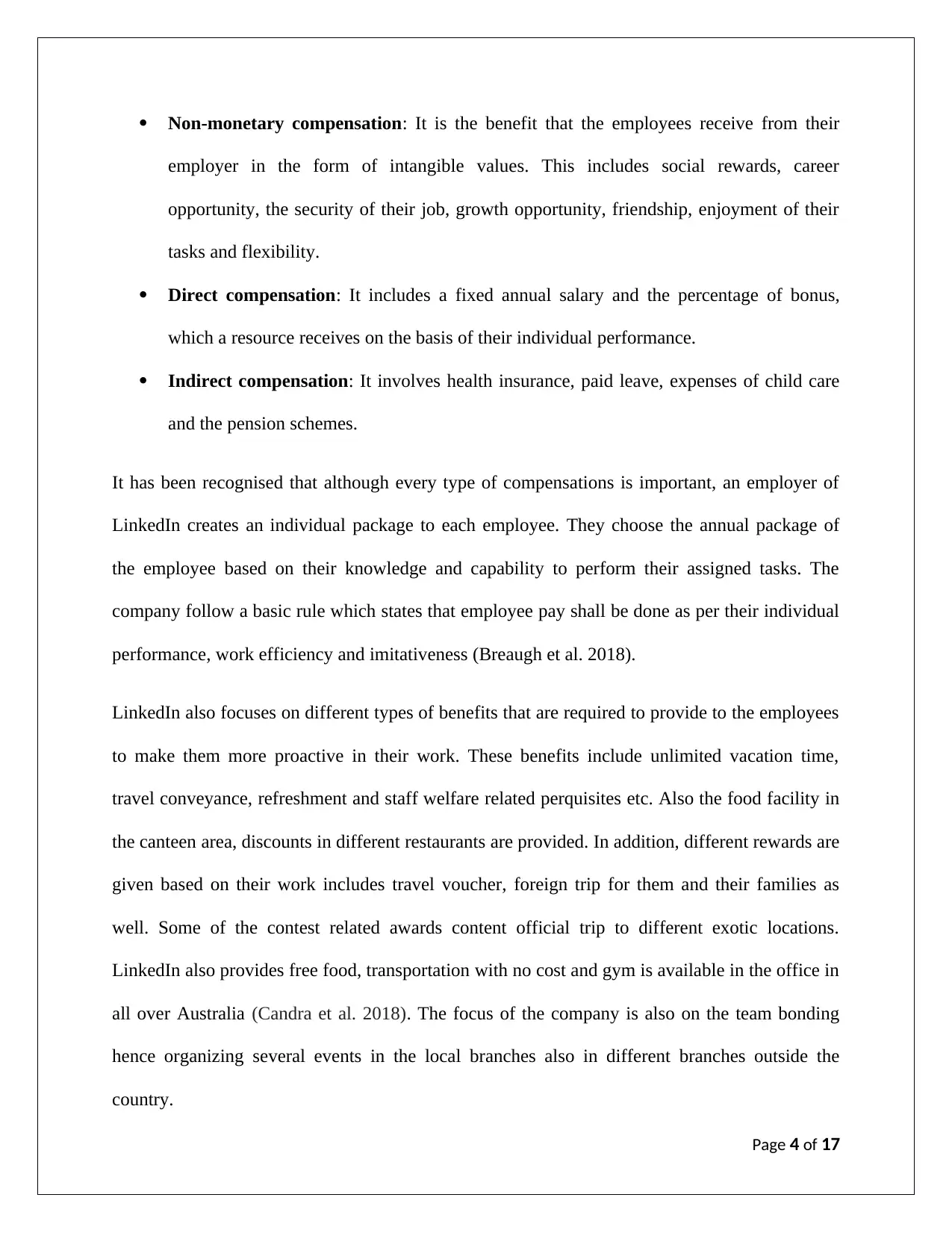
Non-monetary compensation: It is the benefit that the employees receive from their
employer in the form of intangible values. This includes social rewards, career
opportunity, the security of their job, growth opportunity, friendship, enjoyment of their
tasks and flexibility.
Direct compensation: It includes a fixed annual salary and the percentage of bonus,
which a resource receives on the basis of their individual performance.
Indirect compensation: It involves health insurance, paid leave, expenses of child care
and the pension schemes.
It has been recognised that although every type of compensations is important, an employer of
LinkedIn creates an individual package to each employee. They choose the annual package of
the employee based on their knowledge and capability to perform their assigned tasks. The
company follow a basic rule which states that employee pay shall be done as per their individual
performance, work efficiency and imitativeness (Breaugh et al. 2018).
LinkedIn also focuses on different types of benefits that are required to provide to the employees
to make them more proactive in their work. These benefits include unlimited vacation time,
travel conveyance, refreshment and staff welfare related perquisites etc. Also the food facility in
the canteen area, discounts in different restaurants are provided. In addition, different rewards are
given based on their work includes travel voucher, foreign trip for them and their families as
well. Some of the contest related awards content official trip to different exotic locations.
LinkedIn also provides free food, transportation with no cost and gym is available in the office in
all over Australia (Candra et al. 2018). The focus of the company is also on the team bonding
hence organizing several events in the local branches also in different branches outside the
country.
Page 4 of 17
employer in the form of intangible values. This includes social rewards, career
opportunity, the security of their job, growth opportunity, friendship, enjoyment of their
tasks and flexibility.
Direct compensation: It includes a fixed annual salary and the percentage of bonus,
which a resource receives on the basis of their individual performance.
Indirect compensation: It involves health insurance, paid leave, expenses of child care
and the pension schemes.
It has been recognised that although every type of compensations is important, an employer of
LinkedIn creates an individual package to each employee. They choose the annual package of
the employee based on their knowledge and capability to perform their assigned tasks. The
company follow a basic rule which states that employee pay shall be done as per their individual
performance, work efficiency and imitativeness (Breaugh et al. 2018).
LinkedIn also focuses on different types of benefits that are required to provide to the employees
to make them more proactive in their work. These benefits include unlimited vacation time,
travel conveyance, refreshment and staff welfare related perquisites etc. Also the food facility in
the canteen area, discounts in different restaurants are provided. In addition, different rewards are
given based on their work includes travel voucher, foreign trip for them and their families as
well. Some of the contest related awards content official trip to different exotic locations.
LinkedIn also provides free food, transportation with no cost and gym is available in the office in
all over Australia (Candra et al. 2018). The focus of the company is also on the team bonding
hence organizing several events in the local branches also in different branches outside the
country.
Page 4 of 17
Paraphrase This Document
Need a fresh take? Get an instant paraphrase of this document with our AI Paraphraser
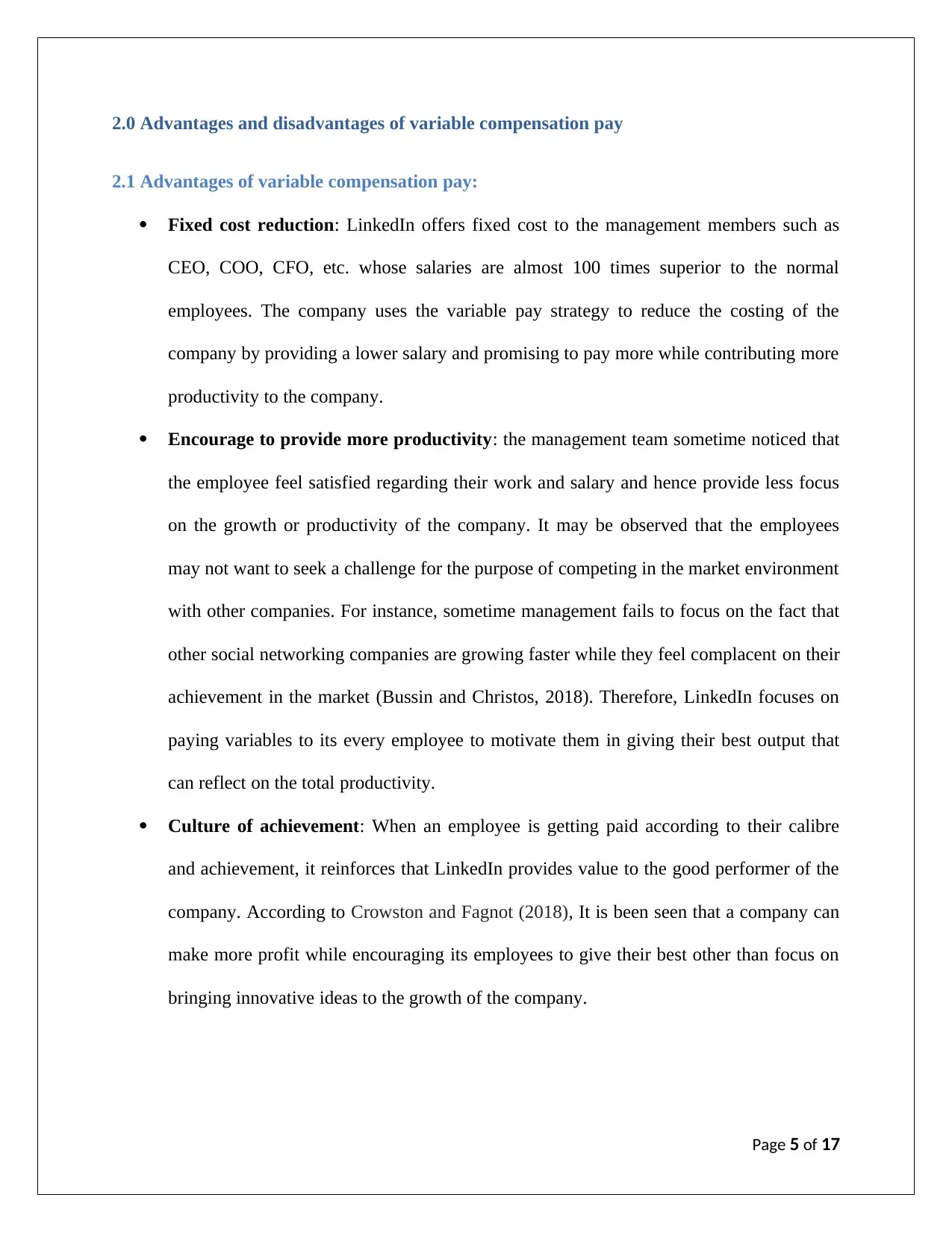
2.0 Advantages and disadvantages of variable compensation pay
2.1 Advantages of variable compensation pay:
Fixed cost reduction: LinkedIn offers fixed cost to the management members such as
CEO, COO, CFO, etc. whose salaries are almost 100 times superior to the normal
employees. The company uses the variable pay strategy to reduce the costing of the
company by providing a lower salary and promising to pay more while contributing more
productivity to the company.
Encourage to provide more productivity: the management team sometime noticed that
the employee feel satisfied regarding their work and salary and hence provide less focus
on the growth or productivity of the company. It may be observed that the employees
may not want to seek a challenge for the purpose of competing in the market environment
with other companies. For instance, sometime management fails to focus on the fact that
other social networking companies are growing faster while they feel complacent on their
achievement in the market (Bussin and Christos, 2018). Therefore, LinkedIn focuses on
paying variables to its every employee to motivate them in giving their best output that
can reflect on the total productivity.
Culture of achievement: When an employee is getting paid according to their calibre
and achievement, it reinforces that LinkedIn provides value to the good performer of the
company. According to Crowston and Fagnot (2018), It is been seen that a company can
make more profit while encouraging its employees to give their best other than focus on
bringing innovative ideas to the growth of the company.
Page 5 of 17
2.1 Advantages of variable compensation pay:
Fixed cost reduction: LinkedIn offers fixed cost to the management members such as
CEO, COO, CFO, etc. whose salaries are almost 100 times superior to the normal
employees. The company uses the variable pay strategy to reduce the costing of the
company by providing a lower salary and promising to pay more while contributing more
productivity to the company.
Encourage to provide more productivity: the management team sometime noticed that
the employee feel satisfied regarding their work and salary and hence provide less focus
on the growth or productivity of the company. It may be observed that the employees
may not want to seek a challenge for the purpose of competing in the market environment
with other companies. For instance, sometime management fails to focus on the fact that
other social networking companies are growing faster while they feel complacent on their
achievement in the market (Bussin and Christos, 2018). Therefore, LinkedIn focuses on
paying variables to its every employee to motivate them in giving their best output that
can reflect on the total productivity.
Culture of achievement: When an employee is getting paid according to their calibre
and achievement, it reinforces that LinkedIn provides value to the good performer of the
company. According to Crowston and Fagnot (2018), It is been seen that a company can
make more profit while encouraging its employees to give their best other than focus on
bringing innovative ideas to the growth of the company.
Page 5 of 17
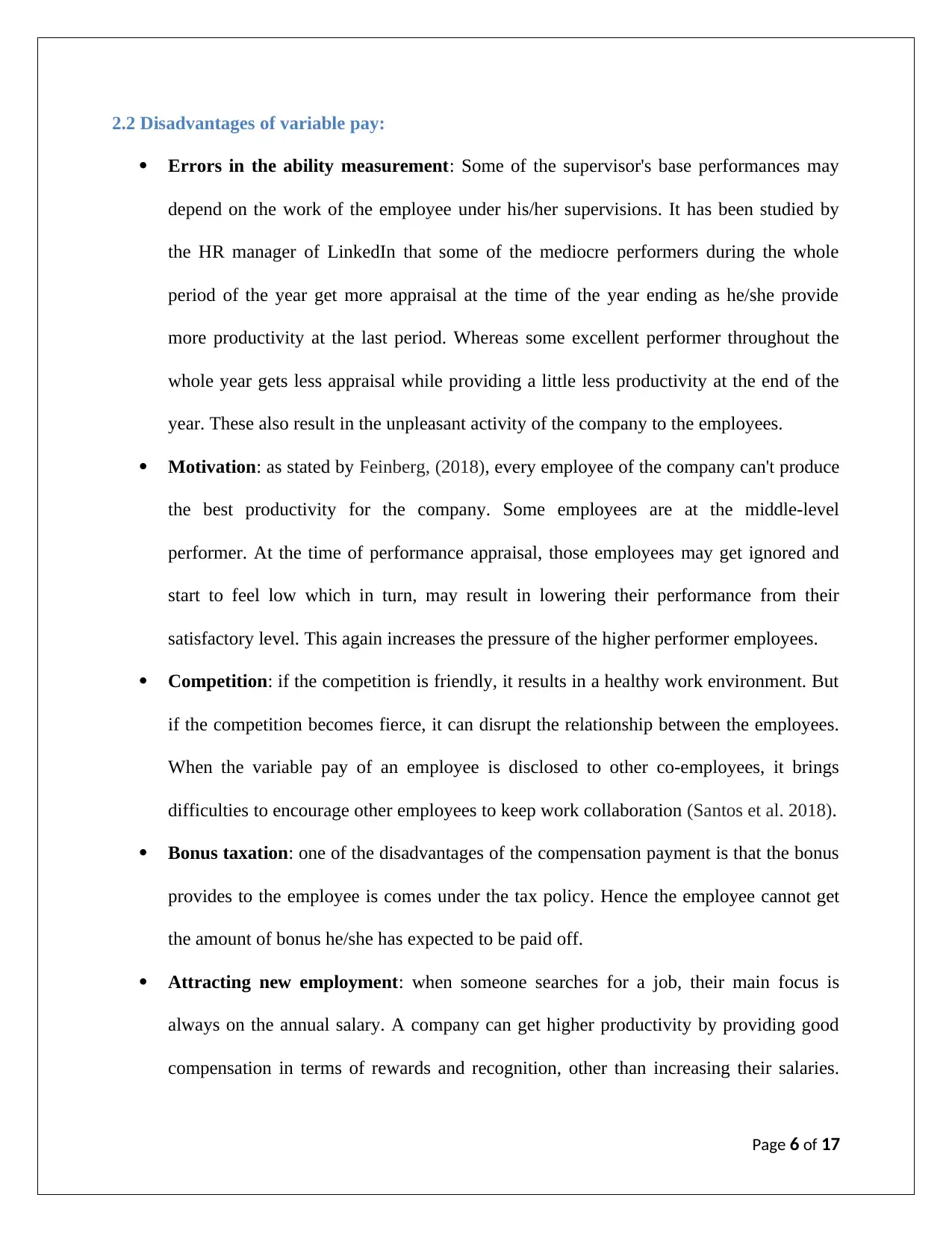
2.2 Disadvantages of variable pay:
Errors in the ability measurement: Some of the supervisor's base performances may
depend on the work of the employee under his/her supervisions. It has been studied by
the HR manager of LinkedIn that some of the mediocre performers during the whole
period of the year get more appraisal at the time of the year ending as he/she provide
more productivity at the last period. Whereas some excellent performer throughout the
whole year gets less appraisal while providing a little less productivity at the end of the
year. These also result in the unpleasant activity of the company to the employees.
Motivation: as stated by Feinberg, (2018), every employee of the company can't produce
the best productivity for the company. Some employees are at the middle-level
performer. At the time of performance appraisal, those employees may get ignored and
start to feel low which in turn, may result in lowering their performance from their
satisfactory level. This again increases the pressure of the higher performer employees.
Competition: if the competition is friendly, it results in a healthy work environment. But
if the competition becomes fierce, it can disrupt the relationship between the employees.
When the variable pay of an employee is disclosed to other co-employees, it brings
difficulties to encourage other employees to keep work collaboration (Santos et al. 2018).
Bonus taxation: one of the disadvantages of the compensation payment is that the bonus
provides to the employee is comes under the tax policy. Hence the employee cannot get
the amount of bonus he/she has expected to be paid off.
Attracting new employment: when someone searches for a job, their main focus is
always on the annual salary. A company can get higher productivity by providing good
compensation in terms of rewards and recognition, other than increasing their salaries.
Page 6 of 17
Errors in the ability measurement: Some of the supervisor's base performances may
depend on the work of the employee under his/her supervisions. It has been studied by
the HR manager of LinkedIn that some of the mediocre performers during the whole
period of the year get more appraisal at the time of the year ending as he/she provide
more productivity at the last period. Whereas some excellent performer throughout the
whole year gets less appraisal while providing a little less productivity at the end of the
year. These also result in the unpleasant activity of the company to the employees.
Motivation: as stated by Feinberg, (2018), every employee of the company can't produce
the best productivity for the company. Some employees are at the middle-level
performer. At the time of performance appraisal, those employees may get ignored and
start to feel low which in turn, may result in lowering their performance from their
satisfactory level. This again increases the pressure of the higher performer employees.
Competition: if the competition is friendly, it results in a healthy work environment. But
if the competition becomes fierce, it can disrupt the relationship between the employees.
When the variable pay of an employee is disclosed to other co-employees, it brings
difficulties to encourage other employees to keep work collaboration (Santos et al. 2018).
Bonus taxation: one of the disadvantages of the compensation payment is that the bonus
provides to the employee is comes under the tax policy. Hence the employee cannot get
the amount of bonus he/she has expected to be paid off.
Attracting new employment: when someone searches for a job, their main focus is
always on the annual salary. A company can get higher productivity by providing good
compensation in terms of rewards and recognition, other than increasing their salaries.
Page 6 of 17
⊘ This is a preview!⊘
Do you want full access?
Subscribe today to unlock all pages.

Trusted by 1+ million students worldwide

However, the aforesaid approach may not attract new talents. It is said by Lau and Lim
(2018), that bonus can be said as “icing on the cake”. It is nice to have them but the
salary is the main substance to the employee.
Page 7 of 17
(2018), that bonus can be said as “icing on the cake”. It is nice to have them but the
salary is the main substance to the employee.
Page 7 of 17
Paraphrase This Document
Need a fresh take? Get an instant paraphrase of this document with our AI Paraphraser
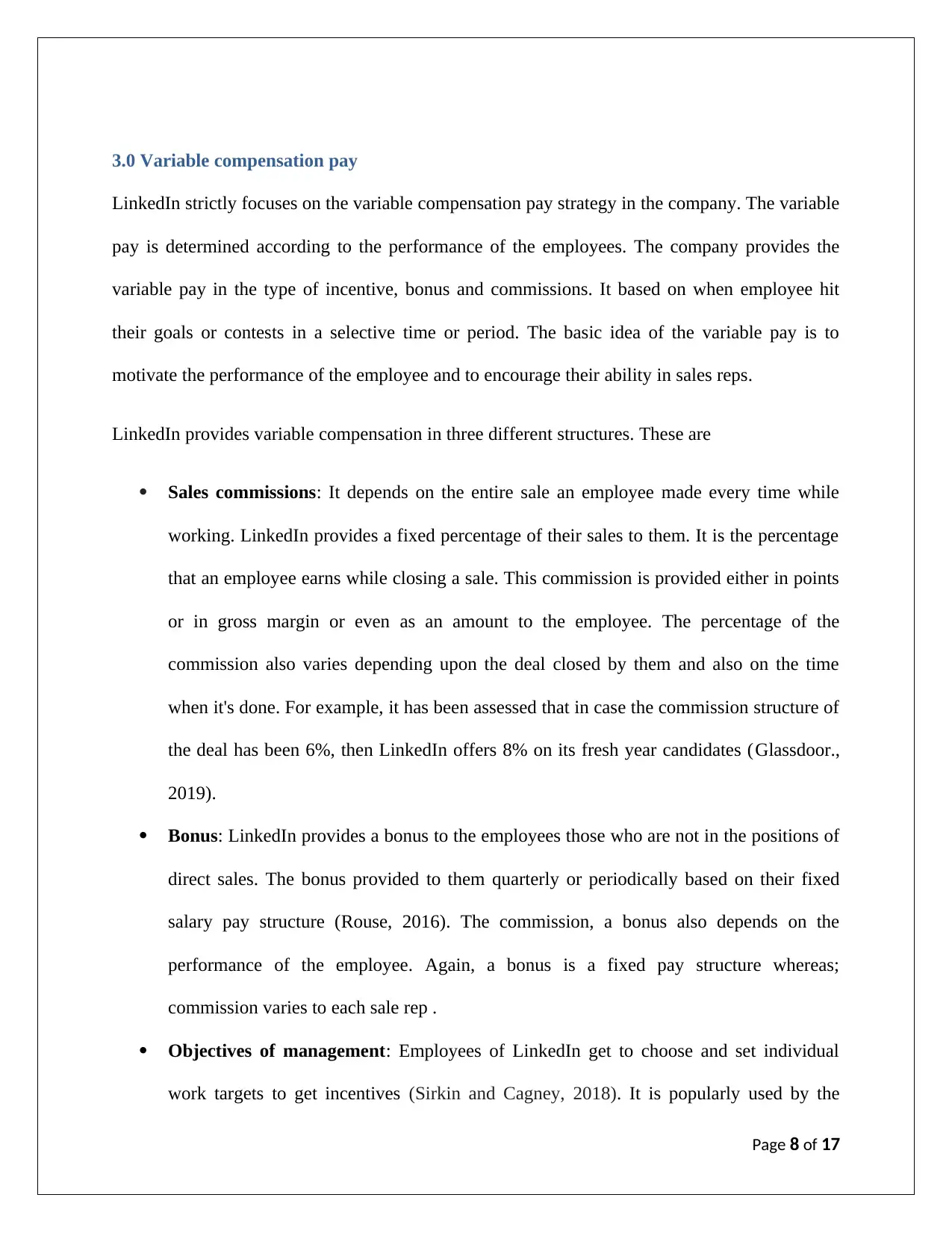
3.0 Variable compensation pay
LinkedIn strictly focuses on the variable compensation pay strategy in the company. The variable
pay is determined according to the performance of the employees. The company provides the
variable pay in the type of incentive, bonus and commissions. It based on when employee hit
their goals or contests in a selective time or period. The basic idea of the variable pay is to
motivate the performance of the employee and to encourage their ability in sales reps.
LinkedIn provides variable compensation in three different structures. These are
Sales commissions: It depends on the entire sale an employee made every time while
working. LinkedIn provides a fixed percentage of their sales to them. It is the percentage
that an employee earns while closing a sale. This commission is provided either in points
or in gross margin or even as an amount to the employee. The percentage of the
commission also varies depending upon the deal closed by them and also on the time
when it's done. For example, it has been assessed that in case the commission structure of
the deal has been 6%, then LinkedIn offers 8% on its fresh year candidates (Glassdoor.,
2019).
Bonus: LinkedIn provides a bonus to the employees those who are not in the positions of
direct sales. The bonus provided to them quarterly or periodically based on their fixed
salary pay structure (Rouse, 2016). The commission, a bonus also depends on the
performance of the employee. Again, a bonus is a fixed pay structure whereas;
commission varies to each sale rep .
Objectives of management: Employees of LinkedIn get to choose and set individual
work targets to get incentives (Sirkin and Cagney, 2018). It is popularly used by the
Page 8 of 17
LinkedIn strictly focuses on the variable compensation pay strategy in the company. The variable
pay is determined according to the performance of the employees. The company provides the
variable pay in the type of incentive, bonus and commissions. It based on when employee hit
their goals or contests in a selective time or period. The basic idea of the variable pay is to
motivate the performance of the employee and to encourage their ability in sales reps.
LinkedIn provides variable compensation in three different structures. These are
Sales commissions: It depends on the entire sale an employee made every time while
working. LinkedIn provides a fixed percentage of their sales to them. It is the percentage
that an employee earns while closing a sale. This commission is provided either in points
or in gross margin or even as an amount to the employee. The percentage of the
commission also varies depending upon the deal closed by them and also on the time
when it's done. For example, it has been assessed that in case the commission structure of
the deal has been 6%, then LinkedIn offers 8% on its fresh year candidates (Glassdoor.,
2019).
Bonus: LinkedIn provides a bonus to the employees those who are not in the positions of
direct sales. The bonus provided to them quarterly or periodically based on their fixed
salary pay structure (Rouse, 2016). The commission, a bonus also depends on the
performance of the employee. Again, a bonus is a fixed pay structure whereas;
commission varies to each sale rep .
Objectives of management: Employees of LinkedIn get to choose and set individual
work targets to get incentives (Sirkin and Cagney, 2018). It is popularly used by the
Page 8 of 17
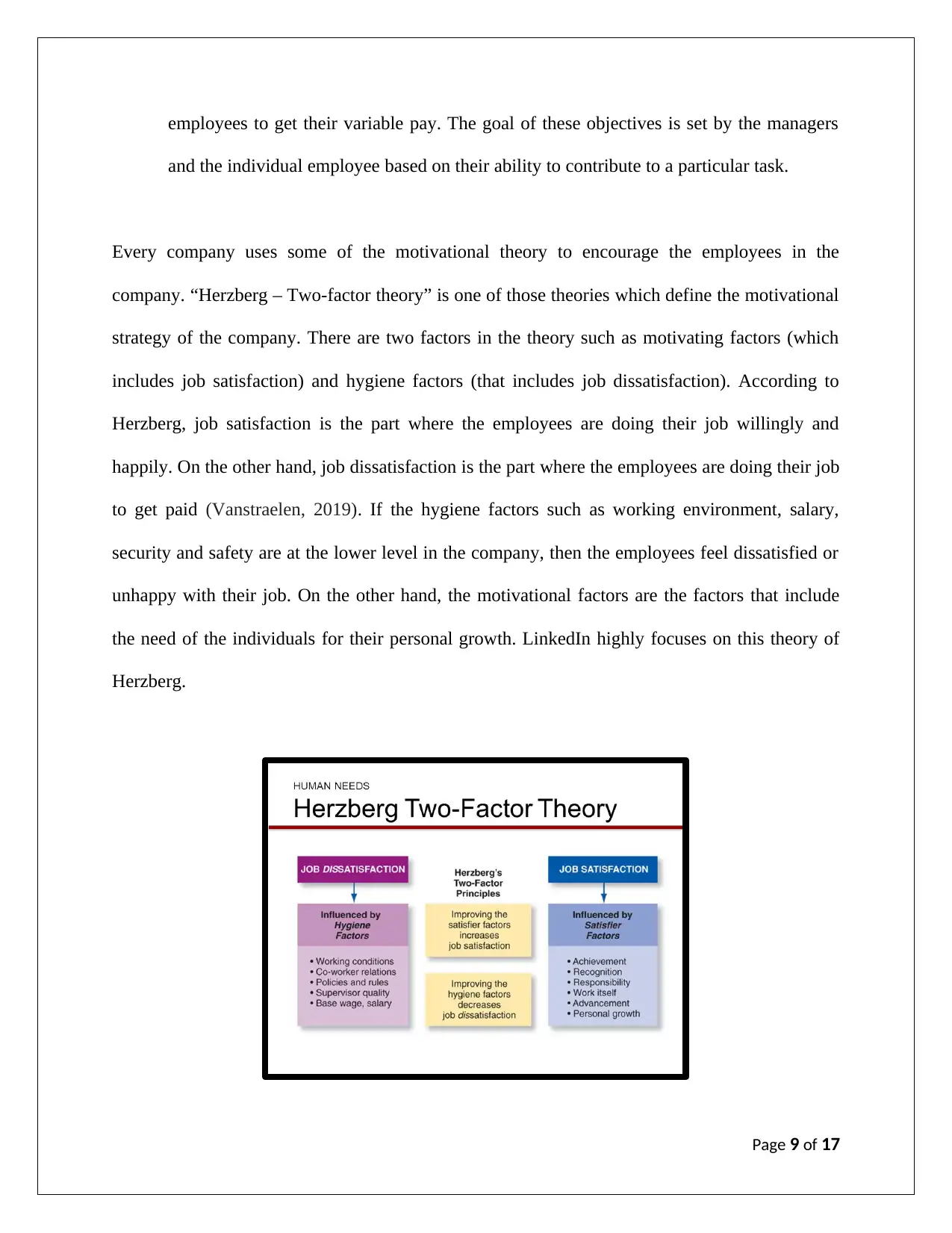
employees to get their variable pay. The goal of these objectives is set by the managers
and the individual employee based on their ability to contribute to a particular task.
Every company uses some of the motivational theory to encourage the employees in the
company. “Herzberg – Two-factor theory” is one of those theories which define the motivational
strategy of the company. There are two factors in the theory such as motivating factors (which
includes job satisfaction) and hygiene factors (that includes job dissatisfaction). According to
Herzberg, job satisfaction is the part where the employees are doing their job willingly and
happily. On the other hand, job dissatisfaction is the part where the employees are doing their job
to get paid (Vanstraelen, 2019). If the hygiene factors such as working environment, salary,
security and safety are at the lower level in the company, then the employees feel dissatisfied or
unhappy with their job. On the other hand, the motivational factors are the factors that include
the need of the individuals for their personal growth. LinkedIn highly focuses on this theory of
Herzberg.
Page 9 of 17
and the individual employee based on their ability to contribute to a particular task.
Every company uses some of the motivational theory to encourage the employees in the
company. “Herzberg – Two-factor theory” is one of those theories which define the motivational
strategy of the company. There are two factors in the theory such as motivating factors (which
includes job satisfaction) and hygiene factors (that includes job dissatisfaction). According to
Herzberg, job satisfaction is the part where the employees are doing their job willingly and
happily. On the other hand, job dissatisfaction is the part where the employees are doing their job
to get paid (Vanstraelen, 2019). If the hygiene factors such as working environment, salary,
security and safety are at the lower level in the company, then the employees feel dissatisfied or
unhappy with their job. On the other hand, the motivational factors are the factors that include
the need of the individuals for their personal growth. LinkedIn highly focuses on this theory of
Herzberg.
Page 9 of 17
⊘ This is a preview!⊘
Do you want full access?
Subscribe today to unlock all pages.

Trusted by 1+ million students worldwide
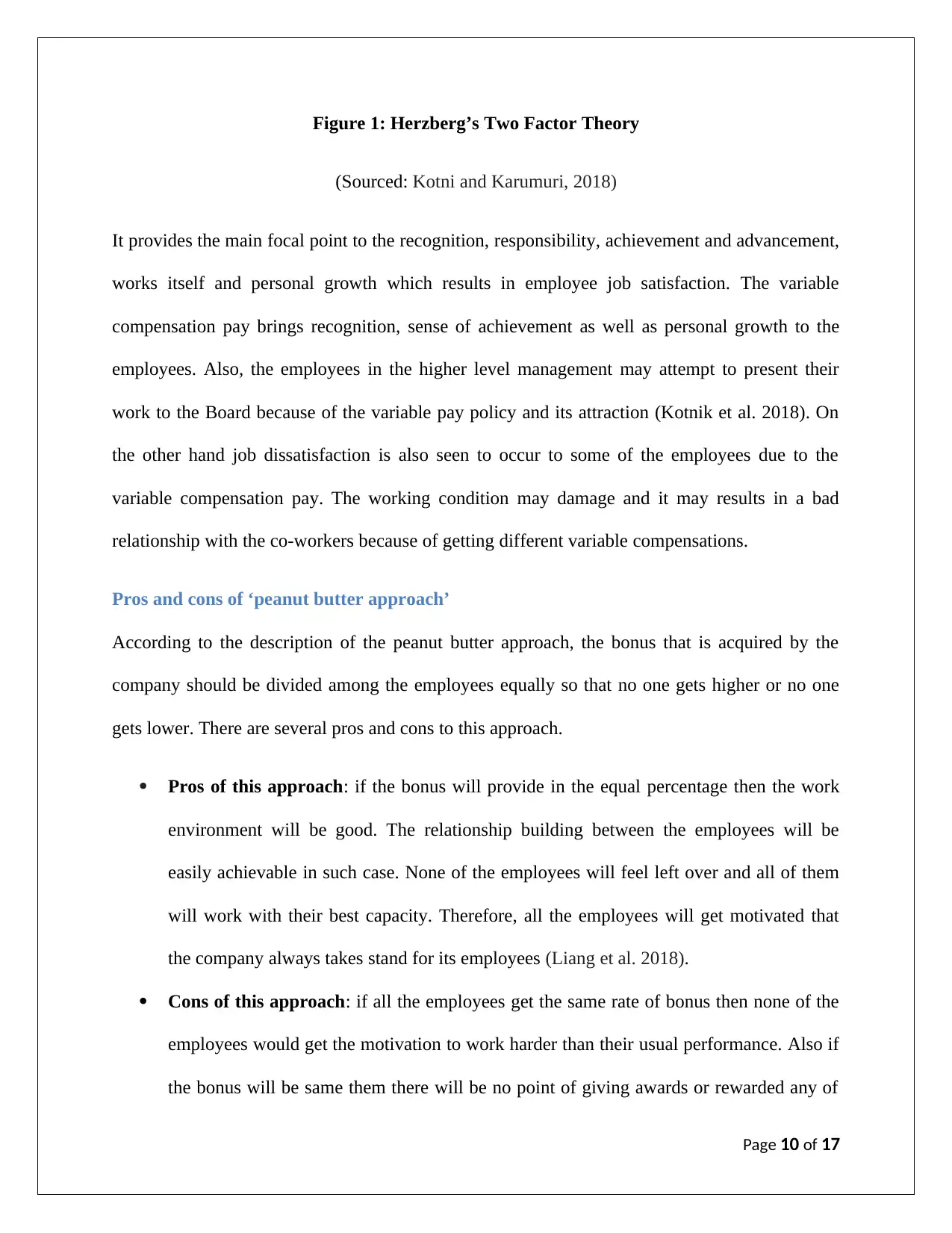
Figure 1: Herzberg’s Two Factor Theory
(Sourced: Kotni and Karumuri, 2018)
It provides the main focal point to the recognition, responsibility, achievement and advancement,
works itself and personal growth which results in employee job satisfaction. The variable
compensation pay brings recognition, sense of achievement as well as personal growth to the
employees. Also, the employees in the higher level management may attempt to present their
work to the Board because of the variable pay policy and its attraction (Kotnik et al. 2018). On
the other hand job dissatisfaction is also seen to occur to some of the employees due to the
variable compensation pay. The working condition may damage and it may results in a bad
relationship with the co-workers because of getting different variable compensations.
Pros and cons of ‘peanut butter approach’
According to the description of the peanut butter approach, the bonus that is acquired by the
company should be divided among the employees equally so that no one gets higher or no one
gets lower. There are several pros and cons to this approach.
Pros of this approach: if the bonus will provide in the equal percentage then the work
environment will be good. The relationship building between the employees will be
easily achievable in such case. None of the employees will feel left over and all of them
will work with their best capacity. Therefore, all the employees will get motivated that
the company always takes stand for its employees (Liang et al. 2018).
Cons of this approach: if all the employees get the same rate of bonus then none of the
employees would get the motivation to work harder than their usual performance. Also if
the bonus will be same them there will be no point of giving awards or rewarded any of
Page 10 of 17
(Sourced: Kotni and Karumuri, 2018)
It provides the main focal point to the recognition, responsibility, achievement and advancement,
works itself and personal growth which results in employee job satisfaction. The variable
compensation pay brings recognition, sense of achievement as well as personal growth to the
employees. Also, the employees in the higher level management may attempt to present their
work to the Board because of the variable pay policy and its attraction (Kotnik et al. 2018). On
the other hand job dissatisfaction is also seen to occur to some of the employees due to the
variable compensation pay. The working condition may damage and it may results in a bad
relationship with the co-workers because of getting different variable compensations.
Pros and cons of ‘peanut butter approach’
According to the description of the peanut butter approach, the bonus that is acquired by the
company should be divided among the employees equally so that no one gets higher or no one
gets lower. There are several pros and cons to this approach.
Pros of this approach: if the bonus will provide in the equal percentage then the work
environment will be good. The relationship building between the employees will be
easily achievable in such case. None of the employees will feel left over and all of them
will work with their best capacity. Therefore, all the employees will get motivated that
the company always takes stand for its employees (Liang et al. 2018).
Cons of this approach: if all the employees get the same rate of bonus then none of the
employees would get the motivation to work harder than their usual performance. Also if
the bonus will be same them there will be no point of giving awards or rewarded any of
Page 10 of 17
Paraphrase This Document
Need a fresh take? Get an instant paraphrase of this document with our AI Paraphraser
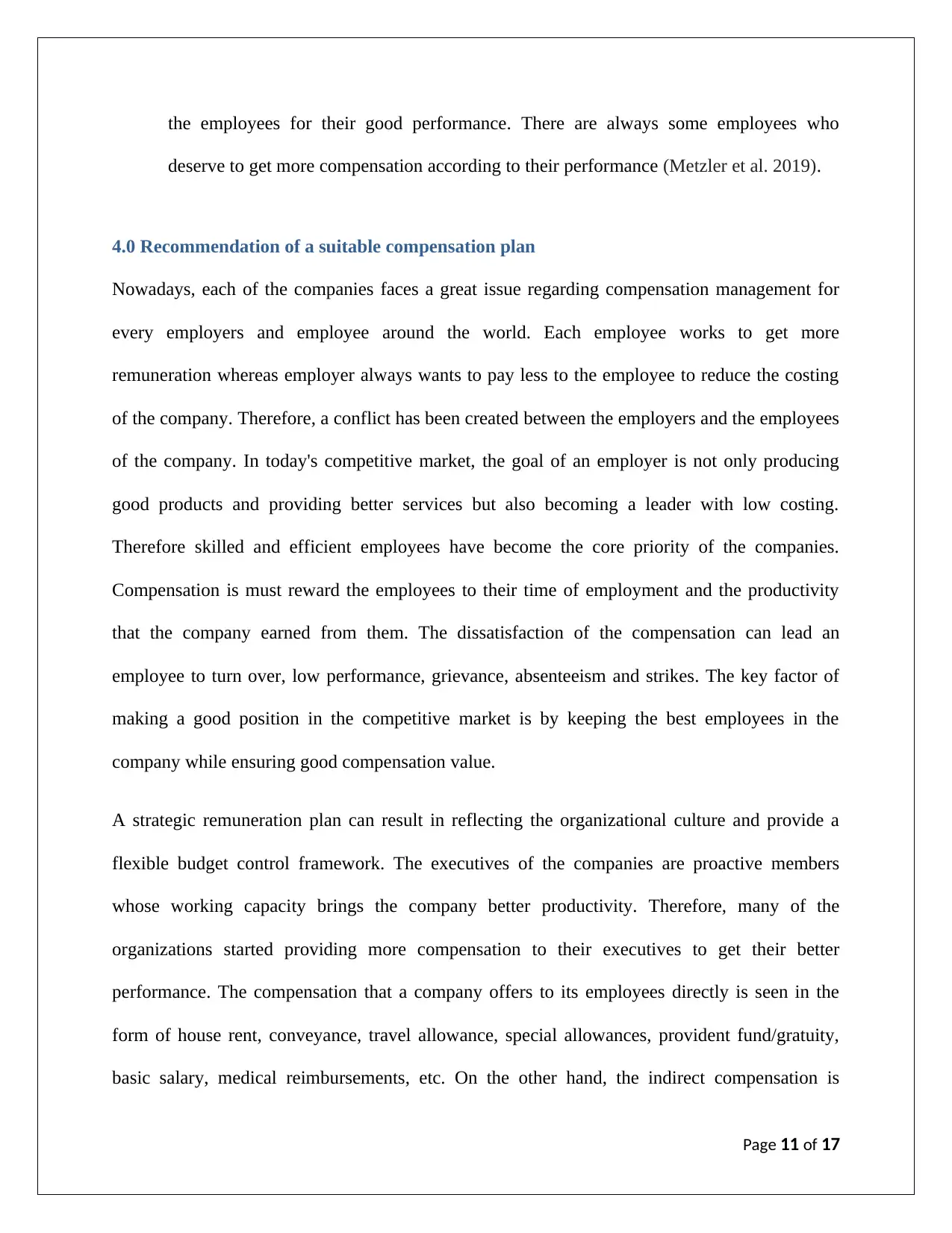
the employees for their good performance. There are always some employees who
deserve to get more compensation according to their performance (Metzler et al. 2019).
4.0 Recommendation of a suitable compensation plan
Nowadays, each of the companies faces a great issue regarding compensation management for
every employers and employee around the world. Each employee works to get more
remuneration whereas employer always wants to pay less to the employee to reduce the costing
of the company. Therefore, a conflict has been created between the employers and the employees
of the company. In today's competitive market, the goal of an employer is not only producing
good products and providing better services but also becoming a leader with low costing.
Therefore skilled and efficient employees have become the core priority of the companies.
Compensation is must reward the employees to their time of employment and the productivity
that the company earned from them. The dissatisfaction of the compensation can lead an
employee to turn over, low performance, grievance, absenteeism and strikes. The key factor of
making a good position in the competitive market is by keeping the best employees in the
company while ensuring good compensation value.
A strategic remuneration plan can result in reflecting the organizational culture and provide a
flexible budget control framework. The executives of the companies are proactive members
whose working capacity brings the company better productivity. Therefore, many of the
organizations started providing more compensation to their executives to get their better
performance. The compensation that a company offers to its employees directly is seen in the
form of house rent, conveyance, travel allowance, special allowances, provident fund/gratuity,
basic salary, medical reimbursements, etc. On the other hand, the indirect compensation is
Page 11 of 17
deserve to get more compensation according to their performance (Metzler et al. 2019).
4.0 Recommendation of a suitable compensation plan
Nowadays, each of the companies faces a great issue regarding compensation management for
every employers and employee around the world. Each employee works to get more
remuneration whereas employer always wants to pay less to the employee to reduce the costing
of the company. Therefore, a conflict has been created between the employers and the employees
of the company. In today's competitive market, the goal of an employer is not only producing
good products and providing better services but also becoming a leader with low costing.
Therefore skilled and efficient employees have become the core priority of the companies.
Compensation is must reward the employees to their time of employment and the productivity
that the company earned from them. The dissatisfaction of the compensation can lead an
employee to turn over, low performance, grievance, absenteeism and strikes. The key factor of
making a good position in the competitive market is by keeping the best employees in the
company while ensuring good compensation value.
A strategic remuneration plan can result in reflecting the organizational culture and provide a
flexible budget control framework. The executives of the companies are proactive members
whose working capacity brings the company better productivity. Therefore, many of the
organizations started providing more compensation to their executives to get their better
performance. The compensation that a company offers to its employees directly is seen in the
form of house rent, conveyance, travel allowance, special allowances, provident fund/gratuity,
basic salary, medical reimbursements, etc. On the other hand, the indirect compensation is
Page 11 of 17
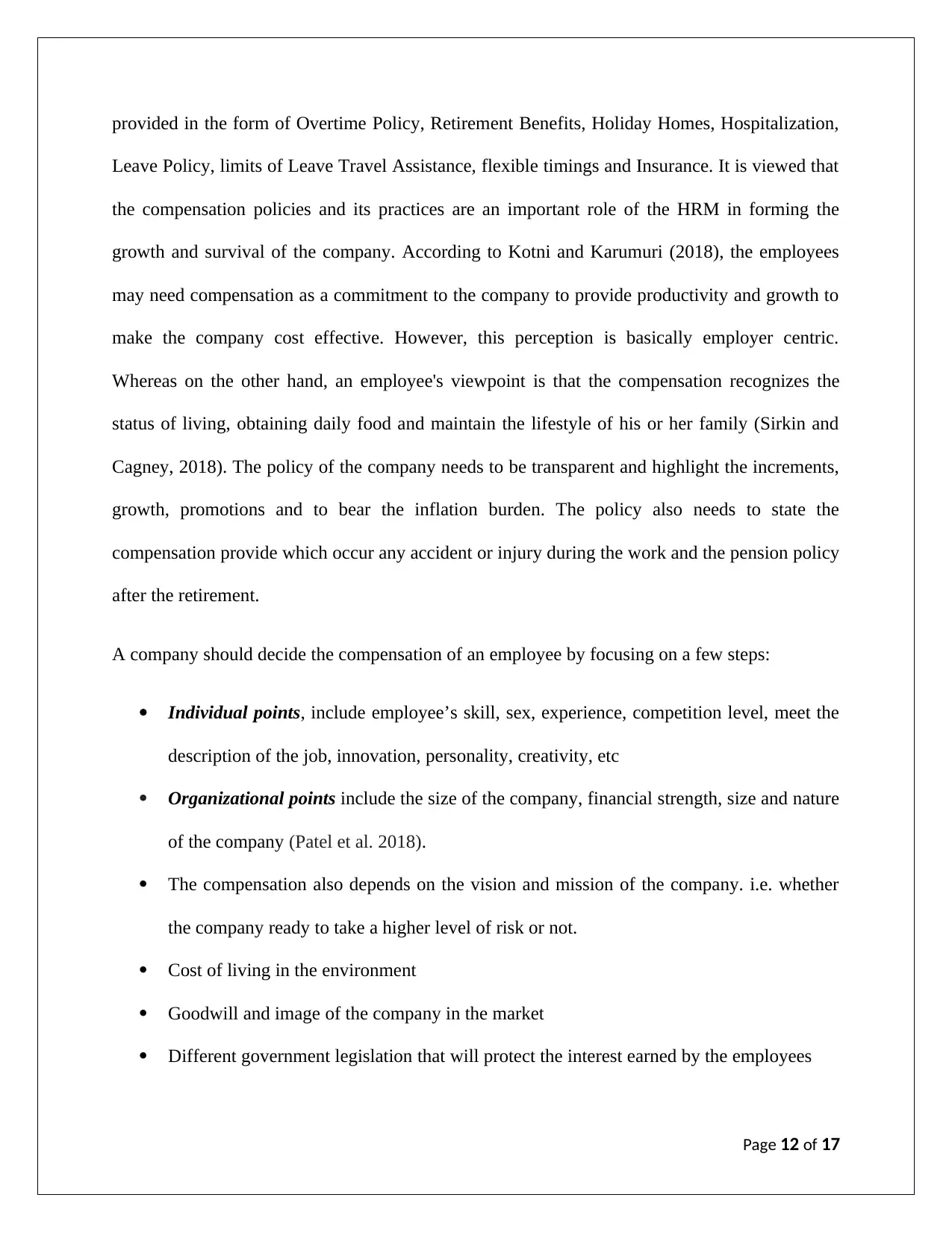
provided in the form of Overtime Policy, Retirement Benefits, Holiday Homes, Hospitalization,
Leave Policy, limits of Leave Travel Assistance, flexible timings and Insurance. It is viewed that
the compensation policies and its practices are an important role of the HRM in forming the
growth and survival of the company. According to Kotni and Karumuri (2018), the employees
may need compensation as a commitment to the company to provide productivity and growth to
make the company cost effective. However, this perception is basically employer centric.
Whereas on the other hand, an employee's viewpoint is that the compensation recognizes the
status of living, obtaining daily food and maintain the lifestyle of his or her family (Sirkin and
Cagney, 2018). The policy of the company needs to be transparent and highlight the increments,
growth, promotions and to bear the inflation burden. The policy also needs to state the
compensation provide which occur any accident or injury during the work and the pension policy
after the retirement.
A company should decide the compensation of an employee by focusing on a few steps:
Individual points, include employee’s skill, sex, experience, competition level, meet the
description of the job, innovation, personality, creativity, etc
Organizational points include the size of the company, financial strength, size and nature
of the company (Patel et al. 2018).
The compensation also depends on the vision and mission of the company. i.e. whether
the company ready to take a higher level of risk or not.
Cost of living in the environment
Goodwill and image of the company in the market
Different government legislation that will protect the interest earned by the employees
Page 12 of 17
Leave Policy, limits of Leave Travel Assistance, flexible timings and Insurance. It is viewed that
the compensation policies and its practices are an important role of the HRM in forming the
growth and survival of the company. According to Kotni and Karumuri (2018), the employees
may need compensation as a commitment to the company to provide productivity and growth to
make the company cost effective. However, this perception is basically employer centric.
Whereas on the other hand, an employee's viewpoint is that the compensation recognizes the
status of living, obtaining daily food and maintain the lifestyle of his or her family (Sirkin and
Cagney, 2018). The policy of the company needs to be transparent and highlight the increments,
growth, promotions and to bear the inflation burden. The policy also needs to state the
compensation provide which occur any accident or injury during the work and the pension policy
after the retirement.
A company should decide the compensation of an employee by focusing on a few steps:
Individual points, include employee’s skill, sex, experience, competition level, meet the
description of the job, innovation, personality, creativity, etc
Organizational points include the size of the company, financial strength, size and nature
of the company (Patel et al. 2018).
The compensation also depends on the vision and mission of the company. i.e. whether
the company ready to take a higher level of risk or not.
Cost of living in the environment
Goodwill and image of the company in the market
Different government legislation that will protect the interest earned by the employees
Page 12 of 17
⊘ This is a preview!⊘
Do you want full access?
Subscribe today to unlock all pages.

Trusted by 1+ million students worldwide
1 out of 17
Related Documents
Your All-in-One AI-Powered Toolkit for Academic Success.
+13062052269
info@desklib.com
Available 24*7 on WhatsApp / Email
![[object Object]](/_next/static/media/star-bottom.7253800d.svg)
Unlock your academic potential
Copyright © 2020–2025 A2Z Services. All Rights Reserved. Developed and managed by ZUCOL.





